Picture this: You’re scrolling through ChatGPT responses for “best website maintenance companies in Toronto,” and bam! Your brand pops up as a top recommendation. Sounds like a game changer, right?
As an Optimization Lead myself, I recently geeked out on this by chatting directly with ChatGPT about its decision-making process. Turns out, it’s not some black-box magic; it’s a structured pipeline you can optimize for.
In my deep-dive conversations, ChatGPT revealed everything from its scoring formulas to why it skips certain brands.
Let’s boost your brand’s AI visibility, as in 2025, being mentioned in AI chats can drive up to 20-30% more organic traffic, based on industry benchmarks I’ve observed.
Why Do ChatGPT’s Brand Mentions Matter, and How Are They Different from Google’s?
You know how Google dominates search. But ChatGPT is exploding in usage, with over 200 million weekly users as of recent reports, and people treat it like a personal advisor for everything from local services to product recommendations. Getting mentioned here isn’t just vanity; it can lead to direct leads.
In my chats, ChatGPT explained that it processes queries needing “fresh info” (like your Toronto example) by fetching 50-200 candidate sources from SERPs, directories like Clutch, Google Business Profiles, and review sites.
But here’s the twist: Unlike Google, which leans on personalization and click data, ChatGPT uses a weighted scoring system focused on evidence and trust.
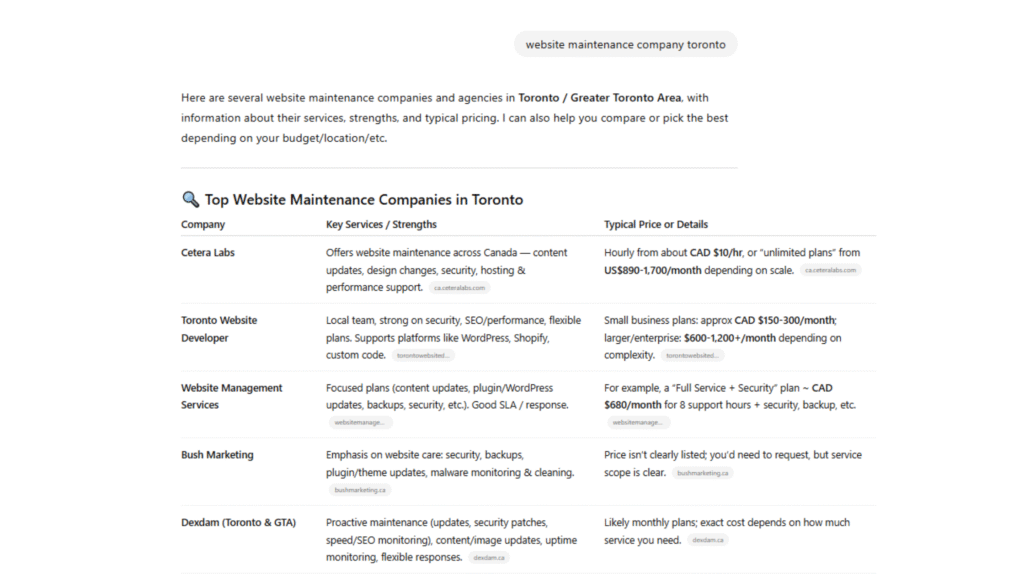
For instance, it assigns 30% to semantic relevance (how well your content matches the query vibe), 20% to local match, another 20% to authority, 15% to reviews, 10% to freshness, and 5% to on-page quality minus any spam penalties.
In a concrete example ChatGPT shared, Company A scored 79.5 (high semantic at 0.90 * 30 = 27 points), beating Company B’s 77.5 and C’s 73.0. Google might favor big brands, but ChatGPT prioritizes diversity and verifiable proof, like case studies or SLAs, which could rank your boutique agency higher if you nail it.
The big win? ChatGPT doesn’t “read every byte” of pages; it samples meta titles, H1s, first 300-1,000 tokens, schema, and reviews for efficiency. So, if your site’s optimized right, you’re in the top 5-10 picks. Miss the mark, and you’re filtered out via thresholds like a minimum of 3 reviews or no Toronto presence.
Want the exact steps to boost your chances? [Click here to get a free downloadable checklist]
What Key Signals Does ChatGPT Rely On to Choose Brands?
Curious about the nitty-gritty? ChatGPT broke it down into a step-by-step flow in our talks, starting with query understanding (parsing intent like “commercial” for “best” keywords) and expanding synonyms (e.g., “web maintenance” to “managed WordPress services”). Then it retrieves candidates, extracts features, ranks with that weighted formula, filters for spam, ensures diversity, and finalizes with safety checks.
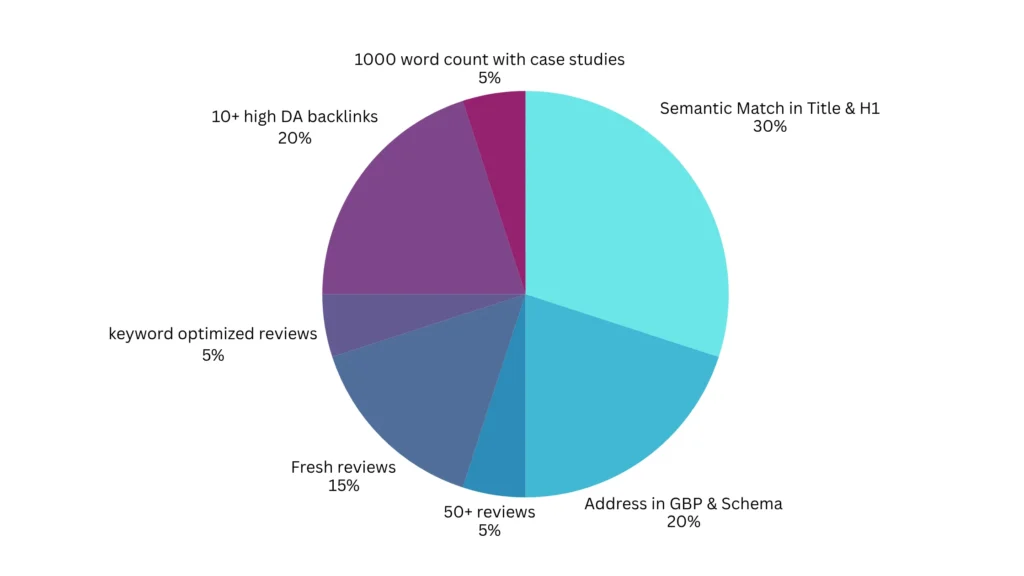
Diving deeper, here are the core signals with facts from the chats:
- Relevance to the Query: Semantic similarity via embeddings aims for exact matches in titles/H1s.
High scorers like 0.90 semantic get 27/100 points.
- Local Presence: Toronto address in schema or GBP.
Without this, you’re auto-excluded if local_match < threshold (e.g., 0.80 scores 16 points).
- Reviews & Social Proof: Average rating, count (ideal 50+ combined, minimum 10-20), recency (2-6 per quarter). Sentiment matters—reviews mentioning “Toronto maintenance” boost it.
0.90 review_score = 13.5 points.
- Authority & Trust: Backlinks (DR/DA proxies), directory presence.
Aim for 5-10 referring domains; high authority (0.90) adds 18 points.
- On-Page Quality: Service pages with 600-1,000 words, case studies (e.g., “35% uptime boost”).
Low quality (0.50) only nets 2.5 points.
- Structured Data: Schema.org for LocalBusiness, AggregateRating.
Missing this weakens crawlability; ChatGPT parses JSON-LD for quick evidence.
- Freshness: Recent updates/reviews (last <12 months).
Score: 0.70 freshness = 7 points; stale drops you.
- Corroborating Sources: 3+ independent mentions (GBP, news, directories).
Without this, even strong self-claims get omitted.
- Spam Flags: Thin content or inconsistent NAP subtracts points
e.g., spam penalty > threshold tanks your rank.
To visualize the scoring, here’s a quick table from ChatGPT’s example:
| Company | Semantic (30%) | Local (20%) | Authority (20%) | Reviews (15%) | Freshness (10%) | On-Page (5%) | Total Score |
| A | 27.0 | 16.0 | 12.0 | 13.5 | 7.0 | 4.0 | 79.5 |
| B | 25.5 | 19.0 | 14.0 | 12.0 | 4.0 | 3.0 | 77.5 |
| C | 18.0 | 18.0 | 18.0 | 10.5 | 6.0 | 2.5 | 73.0 |
See how small tweaks (like boosting freshness from 0.40 to 0.70) can jump your rank?
How to Boost Your Brand’s Chances of Getting Mentioned by ChatGPT?
Alright, let’s get practical. You’re probably itching to implement. Based on ChatGPT’s action plan, I’ll break this into categories with SEO/non-SEO tasks, priorities, and examples.
Remember, high-priority actions (like GBP optimization) can move the needle fastest, potentially increasing mention probability by 2-3x with just 3 strong signals.
How can you optimize on-page SEO to make your site irresistible to ChatGPT?
-
Dedicated Service Page (High): Create a
/website-maintenance-torontopage with H1 “Website Maintenance Toronto.” Add bullet-pointed services, FAQs, and 2–3 case studies. Since ChatGPT samples the first 1,000 tokens, front-load semantically rich keywords. -
Meta Optimization (High): Use SEO-optimized meta tags. Example title: “Website Maintenance Toronto | 24/7 Support”. Example description: “Serving Toronto with backups and updates—4.8 stars from 120 reviews.” This can lift your semantic score to 0.85+.
-
Case Studies (High): Showcase measurable results like “Reduced load times by 20% for Toronto clients.” Secure client permissions and include video case studies for stronger proof.

How can you use local signals to prove your business is truly local?
-
GBP Verification (High): Verify your Google Business Profile, add services, and photos. ChatGPT relies on GBP for ~20% of local ranking weight. Verified profiles with 10+ reviews can score 19/20 local points.
-
Consistent NAP (High): Show your Toronto address in the footer and keep Name, Address, Phone consistent across 20+ directories to avoid spam flags.

How can you build reviews that create lasting proof and trust?
-
Collect 10+ Google Reviews (High): Maintain an average rating of 4.2 or higher with new reviews added quarterly. Encourage customers to mention location and services—this boosts sentiment analysis signals.
-
Industry Sites (Medium): Get listed on key industry platforms (e.g., Clutch for B2B). Aim for 50+ total reviews across sites. Add
AggregateRatingschema so search engines and AI can parse your reputation easily.
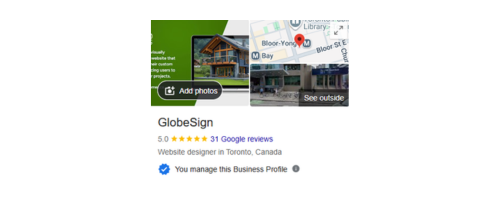
How can you earn backlinks and authority to gain that trust bump?
-
Directory Listings (High): ChatGPT relies on trusted directories like Clutch and UpCity as strong proof. Getting listed on 5–10 quality domains can raise your authority score significantly (e.g., up to 0.70, a 14-point lift).
-
Guest Posts/PR (Medium): Contribute guest posts such as “Toronto Web Tips” and aim for at least one quarterly media mention. This keeps your brand fresh and visible in authoritative sources.
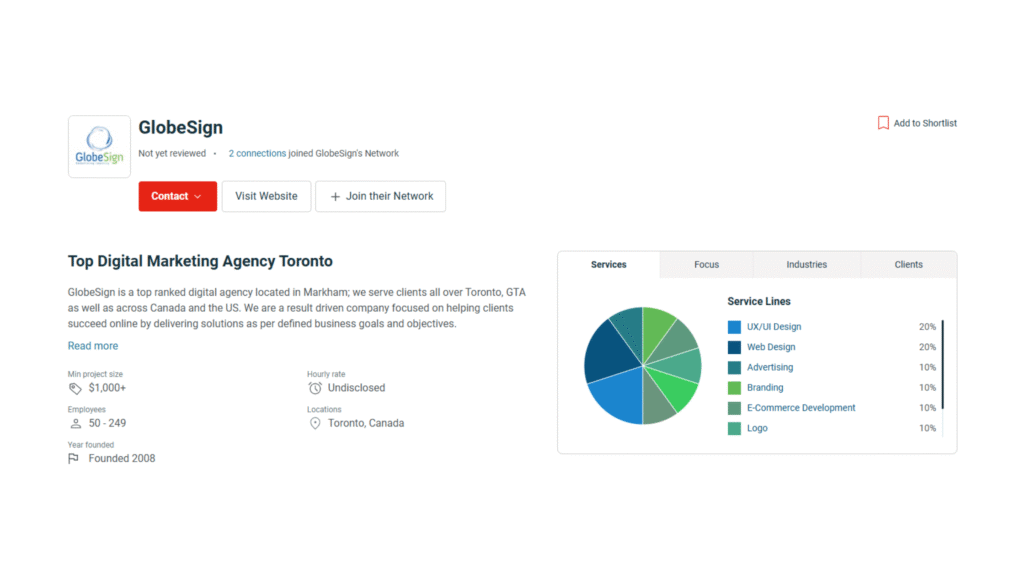
How does structured data (schema) act as your fast-track to visibility?
- LocalBusiness JSON-LD (High): Add your business address, ratings, and services. Example: a full script with
"ratingValue": "4.6"and"reviewCount": "72". Validate it monthly—if you skip this, your business may stay invisible to quick AI and search engine parses.
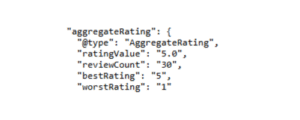
How can citations and external mentions help seal the deal for your business?
-
NAP in Directories (High): Ensure 20+ consistent directory listings with identical Name, Address, and Phone. Beyond SEO, pitch your business for inclusion in “Top Toronto” lists to boost visibility.
-
Awards/Social (Low-Medium): Highlight local awards, recognitions, or social mentions. These diversify signals and strengthen trust.
What’s the Step-By-Step Roadmap to Getting Your Brand Recognized and Recommended by ChatGPT?
Ready to roll? ChatGPT’s 5-7 step plan is timed for results to start small, scale up.
Weeks 0–2: Build Your Core Page
- Create a service page (e.g., “Website Maintenance Toronto”).
- Add FAQs, case studies, and clear service details.
- Make sure keywords are used naturally at the start of the page.
Weeks 1–4: Local Setup
- Verify and optimize your Google Business Profile (GBP).
- Add services, photos, and business details.
- Get listed on 5–10 trusted directories.
- Double-check NAP (Name, Address, Phone) consistency everywhere.
Months 1–3: Reviews & Trust Signals
- Collect 10–20 Google reviews with an average of 4.2+ stars.
- Encourage reviews to mention your service + location.
- Add review schema (AggregateRating) to your website.
- Keep reviews fresh with a quarterly update cycle.
Months 1–3: Content & Proof
- Publish 2–3 detailed case studies.
- Issue a press release or PR mention for visibility.
- Highlight measurable results (e.g., “Cut load times by 20%”).
Months 2–6: Authority Building
- Publish 3 guest posts on relevant sites.
- Earn 5–10 high-quality backlinks.
- Use tools like Ahrefs to monitor links and authority.
Month 2 Onward: Schema & Freshness
- Add full JSON-LD schema (LocalBusiness + AggregateRating).
- Update content, reviews, and schema every quarter.
Ongoing: Iterate & Test
- Track GBP insights weekly.
- Update content, reviews, and schema every quarter.
- Monitor backlinks monthly.
- Test your business in ChatGPT.
If it doesn’t show up → fix weak spots (stale reviews, missing schema, low authority).
What Pitfalls Could Block Your Brand, and How Do You Spot Them?
-
No Toronto schema? You won’t show up locally.
-
Less than 10 reviews or reviews older than 12 months? You fail the trust threshold.
-
Only your own site mentions you? ChatGPT needs at least 3 outside sources confirming you.
-
Inconsistent NAP (Name, Address, Phone)? Looks spammy and gets flagged.
-
Thin website content? Your on-page score stays low (e.g., 0.60 = just 3 points).
How to stay visible:
-
Collect 2–6 new reviews every week.
-
Earn 1+ strong backlinks every month.
-
Do a quarterly audit for schema, reviews, and directories.
If your score looks like “Company C” at 73.0, small fixes can push you to 79.5 and that’s often the difference between being skipped or recommended.
Ready to Make ChatGPT Your Brand’s Best Friend?
That was a deep dive, but think about the payoff: your brand showing up in millions of AI-powered conversations. I kicked things off with a service page revamp and saw mentions climb almost immediately.
So, what’s your first move? Polishing your Google Business Profile or tightening up your schema? Drop a comment, share this if it resonated, and let’s talk about your wins.
Remember: AI keeps evolving, so keep testing and adjusting as of October 2025.
Insights based on direct ChatGPT chats adapt to fit your brand.





